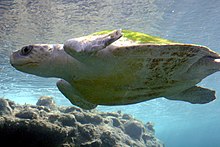Marine turtles
| Sea turtles Temporal range: Early Cretaceous-Holocene,110–0 Ma |
|
|---|---|
 |
|
| An olive ridley sea turtle, a species of the sea turtle superfamily | |
| Scientific classification | |
| Kingdom: | Animalia |
| Phylum: | Chordata |
| Class: | Reptilia |
| Order: | Testudines |
| Suborder: | Cryptodira |
| Clade: | Americhelydia |
| Clade: | Panchelonioidea |
| Superfamily: |
Chelonioidea Bauer, 1893 |
| Type species | |
|
Chelonia mydas Linnaeus, 1758 |
|
| Families | |
| Synonyms | |
|
Chelonii - Oppel 1811 |
|
Chelonii - Oppel 1811
Chlonopteria - Rafinesque 1814
Cheloniae - Schmid 1819
Edigitata - Haworth 1825
Oiacopodae - Wagler 1828
Pterodactyli - Mayer 1849
Sea turtles (superfamily Chelonioidea), sometimes called marine turtles, are reptiles of the order Testudines. The seven extant species of sea turtles are: the green, loggerhead, Kemp's ridley, olive ridley, hawksbill, flatback, and leatherback.
The majority of a sea turtle's body is protected by its shell. The turtle's shell is divided into two sections: carapace (the dorsal portion) and plastron (the ventral portion). The shell is made up of smaller plates called scutes. The leatherback is the only sea turtle that does not have a hard shell. Instead, it bears a mosaic of bony plates beneath its leathery skin.
In general, sea turtles have a more fusiform body plan than their terrestrial or freshwater counterparts. The reduced volume of a fusiform body means sea turtles can not retract their head, legs, and arms into their shells for protection like other turtles can. However this more stream-line body plan reduces drag in the water and allows the turtle to swim more easily.
The leatherback is the largest species of sea turtle. Measuring 2–3 meters (6–9 ft) in length, and 1-1.5 m (3–5 ft) in width, weighing up to 700 kilograms (1500 lb). Other species are smaller, being mostly 60–120 cm (2–4 ft) and proportionally narrower.
Sea turtles, along with other turtles and tortoises, are part of the order Testudines. All species except the leatherback are in the family Cheloniidae. The leatherback is the only extant member of the family Dermochelyidae.
The origin of sea turtles goes back to the Late Jurassic (150 million years ago) with genera such as Plesiochelys, from Europe. In Africa, the first marine turtle is Angolachelys, from the Turonian of Angola. However, neither of these are related to extant sea turtles; the oldest representative of the lineage leading to these was , from the Early Cretaceous.
...
Wikipedia
